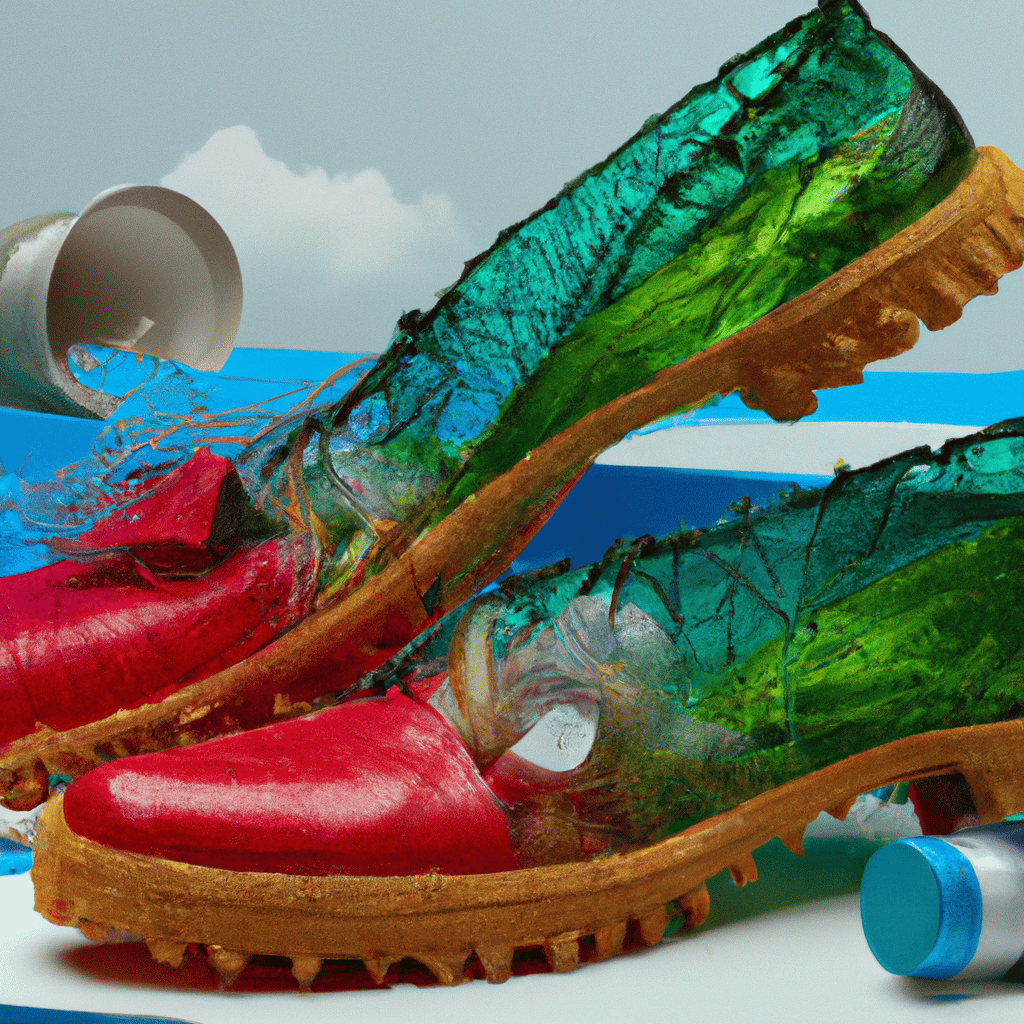Introduction
Hey there, fellow shoe enthusiast! Ever heard of recycled shoes? If not, don’t worry! Let’s take this journey together as we dive into the world of sustainable footwear.
Understanding Recycled Shoes
What are Recycled Shoes?
Think of recycled shoes as the superheroes of the footwear world. They’re made from materials that were once something else entirely, like plastic bottles or even discarded shoes. It’s like giving your trash a new life, only this time, on your feet!
Why Should We Consider Recycled Shoes?
Well, first off, who doesn’t love being a part of something good? By choosing recycled shoes, you’re contributing to a healthier planet. Plus, it’s a great conversation starter: “Hey, did you know my shoes used to be plastic bottles?” Intriguing, isn’t it?
The Evolution of Recycled Shoes
The Past
In the yesteryears, shoe production was heavily dependent on materials like synthetic rubber, leather, and plastic – all resource-intensive and harmful to our planet. There was a disconnect between footwear and environmental sustainability; shoes were often seen as disposable items destined for the landfill after use. However, as environmental consciousness grew, a few trailblazers in the industry began to explore how to turn this around. This marked the humble beginnings of recycled shoes made from reused materials such as rubber tires or industrial waste. This novelty received mixed reviews, but it was a start. The pioneers dared to think differently, paving the way for a revolution in the shoe industry.
The Present
Fast forward to the present day, recycled shoes have now taken center stage. Advancements in technology have allowed manufacturers to transform waste materials like plastic bottles and fishing nets into usable raw materials for shoe production. And it’s not just niche, environmentally-focused brands leading the way. Global footwear giants like Adidas and Nike have also jumped on the sustainability bandwagon, launching their own lines of recycled shoes. This isn’t just a fashion statement anymore – it’s becoming the norm. Recycled shoes have now gone mainstream, and they’re not just worn by environmental enthusiasts but sportspeople, fashionistas, and everyday individuals who value style, comfort, and sustainability.
The Future
As we look towards the future, the possibilities for sustainable shoe brands are truly exciting. With ongoing technological innovations and a growing commitment to sustainability, we can expect to see shoes made from an even wider range of recycled materials. Imagine shoes crafted from recycled electronics, agricultural waste, or even food scraps! Moreover, brands are also working towards creating shoes that are not just made from recycled materials but are fully recyclable themselves. The dream is to achieve a closed-loop system where old shoes can be completely turned into new ones, minimizing waste and maximizing resource efficiency. This is the future of footwear – a world where every pair of shoes has a past life and a future purpose, reducing our environmental footprint one step at a time.
The Science Behind Recycled Shoes
Step 1: Collection of Materials
The process starts with the gathering of recyclable materials. These materials are collected from various sources, from plastic bottles and fishing nets to used car tires and textile wastes. Each piece of waste is a potential building block for a new pair of shoes.
Step 2: Sorting and Cleaning
Next, the collected waste materials need to be sorted and cleaned. Sorting is essential to separate different materials, while cleaning removes any impurities or unwanted residues. It’s a bit like doing laundry but on an industrial scale!
Step 3: Shredding
Once cleaned, the materials are shredded into small pieces. This is often done using industrial shredders. Think of it like your home paper shredder, but way bigger and more powerful. The end result is a pile of small scraps ready for the next step.
Step 4: Processing into Raw Materials
Here’s where the real transformation begins. Depending on the type of waste, different processes are used. Plastic, for example, is melted down and extruded into threads. On the other hand, rubber from tires is often ground down into fine particles. It’s a bit like cooking – different recipes require different ingredients and processes.
Step 5: Material Creation
After the processing, we get the raw material used to make the shoe. The plastic threads can be spun into yarn, which can be woven into the fabric for the shoe’s upper part. Rubber particles can be molded into the sole of the shoe. It’s like knitting a sweater or molding clay but for shoes!
Step 6: Assembly
Finally, the parts made from recycled materials are assembled into the final product – a pair of shoes. This involves cutting the materials into specific shapes and sizes and stitching or gluing them together. The end product is a pair of stylish, comfortable, and, most importantly, environmentally-friendly shoes.
Step 7: Quality Check
But we’re not done yet! Each pair of shoes undergo rigorous quality checks to ensure they meet the brand’s standards. After all, just because they’re made from recycled materials doesn’t mean they should fall apart after a few wears. If a pair of shoes doesn’t pass the quality check, it’s back to the drawing board!
So there you have it – the fascinating journey of waste becoming wearable, step by step. It’s an intricate process that marries science and creativity, leading to a product that’s not just good for your feet but also the planet.
Impact of Recycled Shoes on the Environment
Eco-friendly Footprints
By wearing recycled shoes, you’re reducing waste, conserving resources, and even cutting down on carbon emissions. You’re basically a walking, talking eco-warrior!
Comparative Analysis: Recycled Shoes vs Regular Shoes
If we pit recycled shoes against regular shoes, who’d win? Regarding environmental impact, recycled shoes knock it out of the park. They use less energy to produce and help keep waste out of our landfills. It’s a win-win!
Benefits of Recycled Shoes
Lowering Carbon Footprint
Recycling materials for shoe production reduces the energy and raw materials needed compared to traditional manufacturing. This lower energy consumption results in fewer greenhouse gas emissions. It’s as if every step you take in recycled shoes is a breath of fresh air for our planet.
Conserving Natural Resources
Recycled shoes also help conserve natural resources by reusing materials that would otherwise end up in landfills or oceans. This means fewer trees cut down for rubber, less oil extracted for plastics, and a healthier balance in our ecosystems. Think of it as giving Mother Nature a much-needed break!
Creating a Circular Economy
Recycled shoes contribute to a circular economy where waste is not waste but a resource for new products. This model keeps materials in use for as long as possible, extracts the maximum value from them, and recovers and regenerates products at the end of their life. It’s like turning the traditional, linear “take, make, dispose” model on its head!
Critiques of Recycled Shoes
Sustainability Questions
While recycled shoes are a step in the right direction, some critics argue that they’re not a silver bullet solution for environmental sustainability. They point out that even though the shoes are made from recycled materials, the energy and resources required for the recycling process could still have a significant environmental impact. Is it better to recycle a plastic bottle into a shoe or not to create a plastic bottle in the first place?
The Issue of ‘Greenwashing’
Greenwashing’ is a term used when companies make unsubstantiated or misleading claims about the environmental benefits of their products. With the rise in demand for eco-friendly products, some critics are wary of brands that advertise their products as ‘recycled’ or ‘sustainable’. They caution consumers to research and ensure that the companies are transparent about their production processes.
Durability Concerns
There are also concerns about the durability and longevity of recycled shoes. Some critics question if recycled shoes can withstand the same amount of wear and tear as traditional shoes or if they might end up in the landfill sooner, thus negating their environmental benefits.
Limited Recycling Capabilities
Another critique is that not all materials used in shoes are currently recyclable, meaning that even recycled shoes can still contribute to waste at the end of their lifecycle. While there are ongoing efforts to develop shoes that are 100% recyclable, we are not there yet.
Overconsumption
Lastly, recycled shoes may be more sustainable but could unintentionally encourage overconsumption. Consumers may buy more shoes than necessary because they believe they’re making an environmentally friendly choice, not realizing that the most sustainable option is often to consume less overall.
Each of these critiques provides an important perspective to consider as we navigate toward a more sustainable future in footwear. It’s a reminder that while recycled shoes are a positive development, there’s still much work to be done in the journey toward true sustainability.
Your Role in the Movement
As consumers, we play a vital role in this sustainable movement. By purchasing recycled shoes, we’re voting with our wallets and showing companies that we support environmentally friendly products. It’s not just about wearing recycled shoes but embracing a lifestyle that prioritizes sustainability in all forms.
Choosing Your Perfect Pair of Recycled Shoes
What to Look for When Buying Recycled Shoes
Quality and comfort are key. Just because it’s recycled doesn’t mean it should feel like you’re walking on a bed of nails. Make sure to try before you buy, and stroll around the store to ensure a perfect fit.
Top Brands to Consider
Adidas
Adidas is one of the big names in the shoe industry, making waves with their eco-friendly initiatives. Their Adidas x Parley collection, created in collaboration with the environmental group Parley for the Oceans, features shoes made from recycled ocean plastic. Stylish, functional, and sustainable, these shoes prove that big brands can lead the way in sustainable fashion.
Nike
Nike, another industry titan, has been investing in sustainable solutions for several years. Their Flyknit technology, used in many of their running shoes, reduces waste because the upper is constructed from a single thread woven into a seamless, sock-like fit. This approach reduces waste by about 60% compared to traditional cut-and-sew methods. They’ve also introduced the Space Hippie line, using scrap materials from their factory floors to create trendy, high-performance shoes.
Rothy’s
Rothy’s is a women’s footwear brand that’s gained a reputation for its sustainable approach. They manufacture trendy flats and loafers from recycled plastic water bottles, proving that sustainable fashion can be vibrant, beautiful, and diverse. Rothy’s has managed to make sustainability trendy and stylish.
Veja
Veja is a French brand that has been championing ethical and sustainable footwear for years. Their shoes are made from various sustainable materials, including organic cotton, wild rubber from the Amazon, and recycled plastic bottles. With a stylish design that doesn’t compromise on comfort, Veja shoes are a testament to eco-conscious fashion.
Reebok
Reebok has made a foray into sustainable footwear with NPC UK Cotton and Corn shoes. As the name suggests, the shoe is made from cotton and corn-based bioplastic. They are also committed to improving the dye process to reduce the chemicals, energy, and water needed for fabric production.
Each of these brands shows that it’s possible to create stylish, comfortable shoes while also being conscious of our environmental impact.
Conclusion
In the grand scheme of things, recycled shoes are more than just footwear. They’re a testament to human ingenuity and our commitment to safeguarding the planet. They remind us that every little action counts and that we can make a difference together. So the next time you need a new pair of shoes, consider choosing recycled ones. Not just for you but for our planet.
FAQs
Can recycled shoes be recycled again?
Yes! Many brands accept their shoes back to be recycled once more. It’s the circle of life, shoe edition.
Are recycled shoes more expensive?
Not necessarily. While some recycled shoes may be pricier due to the innovative technology used, there are also affordable options out there.
Do recycled shoes compromise on comfort or style?
Absolutely not! Recycled shoes can be just as comfortable and stylish as non-recycled ones. They’re proof that you don’t have to sacrifice style for sustainability.
Can I wear recycled shoes for sports?
You bet! Many sports brands now offer athletic shoes made from recycled materials. So you can score goals and environmental points at the same time!
What is the lifespan of recycled shoes?
Recycled shoes can last just as long as regular shoes, depending on how you care for them. They’re not just eco-friendly, they’re built to last!





Pingback: Navigating the World of Sustainable Clothing Brands
Pingback: Compost Spreader: You and Your Garden's Best Friend
Pingback: Compost Tea: The Elixir for Your Garden - Eco Life Wise
Pingback: Solar Water Pump: Sustainable Water Solutions - Eco Life Wise
Pingback: Solar Powered Generator: The Future of Sustainable Energy
Pingback: History of Recycling: A Journey From Trash to Treasure
Pingback: Upcycling: 10 Things You Probably Didn't Know - Eco Life Wise
Pingback: Compostable Trash Bags: The Eco Friendly Choice
Pingback: Eco Friendly Phone Cases: Smart For a Sustainable Lifestyle
Pingback: Organic Modernism: A Resurgence of Nature in Design - Eco Life Wise
Pingback: 20 Brilliant Ways to Upcycle T Shirts: From DIY to Fashion
Pingback: What Is Sustainability? Unlocking the Power to Transform Our World
Pingback: Three Pillars of Sustainability: A Guide to a Better Future
Pingback: What is Biodiversity and Why Should We Care? | Eco Life Wise
Pingback: 7 Fun Facts About Wind Energy That Will Blow You Away | Eco Life Wise
Pingback: Eco Friendly Sustainability: Introducing The GreenPrint Initiative
Pingback: Most Efficient Solar Panels: A Comprehensive Guide
Pingback: Benefits of Recycling: Maximizing Your Impact for a Greener Planet
Pingback: 15 Facts About Recycling You Probably Didn't Know
Pingback: Sustainable Fashion Brands: Redesigning Style Responsibly
Pingback: Recycled Glass Countertops: The Eco-Friendly and Stylish Choice
Pingback: Organic Basics: The Untamed Journey of Green Living
Pingback: Recycling for Kids: Discover the Secrets of Saving the Planet
Pingback: What Does Biodegradable Mean and Why is it a Buzzword? | Eco Life Wise
Pingback: Off Grid Wind Turbine: Harness the Power of Wind | Eco Life Wise
Pingback: Sustainable Bedding: The Ultimate Guide | Eco Life Wise
Pingback: Facts About Recycling: Conserving Resources & Building Sustainability
Pingback: Organic Protein Powder: Nature's Muscle Builder | Eco Life Wise
Pingback: Climate Change: The Facts That Will Make Your Jaw Drop! | Eco Life Wise
Pingback: Sustainable Lingerie: An Eco Friendly Revolution in Your Drawer | Eco Life Wise
Pingback: Sustainable Development: A Bold Approach | Eco Life Wise
Pingback: Climate Change Reality: The Unvarnished Truth We Can't Ignore | Eco Life Wise
Pingback: World Environment Day: A Deep Dive | Eco Life Wise
Pingback: Best Organic Coffee Brands: Your Ultimate Coffee Experience | Eco Life Wise
Pingback: What Are The Pros And Cons Of Nuclear Energy? 10 Points to Spotlight | Eco Life Wise
Pingback: Sustainability vs Resilience: Latest Duel of the Eco-Titans! | Eco Life Wise
Pingback: Facts About Solar Energy: Harnessing the Sun's Power
Pingback: The Solar Battery: Ensuring A Future of Sustainable Energy
Pingback: Unlock Sustainability Goals: Ditch Non-Renewable Polymers for Eco-Alternatives | Eco Life Wise
Pingback: Benefits of Renewable Energy: The Future is Bright (and Windy!) | Eco Life Wise
Pingback: Examples of Natural Resources: Unearthing Earth's Treasures | Eco Life Wise
Pingback: How Can I Reduce My Carbon Footprint? 8 Simple Ways | Eco Life Wise
Pingback: Self Sustainable Homes: 7 Practical Reasons Why You Need One Today! | Eco Life Wise
Pingback: Solar Energy Pros and Cons: 8 Considerations | Eco Life Wise
Pingback: Examples of Sustainability: How They Shape Our World | Eco Life Wise
Pingback: Portable Solar Panels: An Anywhere, Anytime Solution
Pingback: Charge Your Electric Car With Solar Panels: The Ultimate Guide to Green Energy! | Eco Life Wise
Pingback: Commercial Solar Panels: Exploring the Lifespan | Eco Life Wise
Pingback: Sustainable Development Goals: 17 Nuggets
Pingback: What Is The Role Of Trees In Combating Climate Change? | Eco Life Wise
Pingback: What Is A Carbon Footprint: 10 Important Details to Understand | Eco Life Wise
Pingback: What Is The Greenhouse Effect? 9 Important Signs | Eco Life Wise
Pingback: How Do I Start A Zero-Waste Lifestyle? 7 Steps to Success | Eco Life Wise
Pingback: What Are The Benefits Of Using Natural Cleaning Products? 10 Nuggets | Eco Life Wise
Pingback: Is Cardboard Recyclable? You Might Be Surprised | Eco Life Wise
Pingback: Electronics Recycling Process: 3 Important Tips | Eco Life Wise
Pingback: Safely Recycling Lithium Batteries: 13 Things You Should Know | Eco Life Wise
Pingback: How Do Electric Cars Help The Environment? 7 Practical Points to Ponder | Eco Life Wise
Pingback: Solar Development on Brownfields and Landfills: 8 Factors That Unlock Value | Eco Life Wise
Pingback: What Is Sustainable Fashion? 9 Interesting Definitions | Eco Life Wise
Pingback: Why Is Biodiversity Essential For The Environment? 10 Compelling Reasons | Eco Life Wise
Pingback: Renewable Energy Sources: 10 Ways They Help Reduce Greenhouse Emissions | Eco Life Wise
Pingback: What Is The Difference Between Upcycling And Recycling? 5 Unique Differences | Eco Life Wise
Pingback: How Do Urban Gardens Contribute To Sustainability? | Eco Life Wise
Pingback: What Are The Advantages Of Compostable Packaging? | Eco Life Wise
Pingback: Composting Outdoor Gatherings: 19 Eco-Friendly Waste Management Tips | Eco Life Wise
Pingback: How Can We Reduce Electronic Waste? 10 Things We Can Do | Eco Life Wise
Pingback: Sustainable Living: 8 Practical Benefits of the Sustainable Lifestyle | Eco Life Wise
Pingback: What Is Slow Fashion And How Does It Differ From Fast Fashion? | Eco Life Wise
Pingback: What Is A Green Building? | Eco Life Wise
Pingback: What Is A Sustainable Diet? 10 Factors to Consider | Eco Life Wise
Pingback: How Does Self-Sustaining Architecture Differ From Traditional Architecture? 7 Big Ways | Eco Life Wise
Pingback: How Do Rising Sea Levels Affect Coastal Cities? | Eco Life Wise
Pingback: What Is The Difference Between Green And Sustainable? | Eco Life Wise
Pingback: What Are The Harmful Effects Of Ozone Layer Depletion? 10 Compelling Factors | Eco Life Wise
Pingback: Why Is Clean Air Essential For Human Health? | Eco Life Wise
Pingback: What Is A Vegan Lifestyle And How Does It Benefit The Environment? | Eco Life Wise
Pingback: Why Is It Important To Buy Locally Sourced Products? Here's 10 Compelling Reasons | Eco Life Wise
Pingback: What Role Do Materials Play In Self-Sustaining Architecture? 10 Considerations | Eco Life Wise
Pingback: What Is Sustainable Development? | Eco Life Wise
Pingback: Why Is Reducing Meat Consumption Beneficial For The Planet? | Eco Life Wise
Pingback: What Is The Significance Of Earth Day? | Eco Life Wise
Pingback: How Does Carpooling Help Reduce Carbon Emissions? | Eco Life Wise
Pingback: Vegan Shoes | Eco Life Wise
Pingback: Wills Vegan Shoes: 10 Exciting Innovations | Eco Life Wise
Pingback: Vegan Chicken | Eco Life Wise
Pingback: Reusable Beeswax Wrap Review: 10 Innovative Uses | Eco Life Wise
Pingback: Vegan Girl Scout Cookies | Eco Life Wise
Pingback: Vegan Celebrities: 10 Celebrities Who Choose Vegan | Eco Life Wise
Pingback: Vegan Transition Guides: 10 Handy Tips | Eco Life Wise